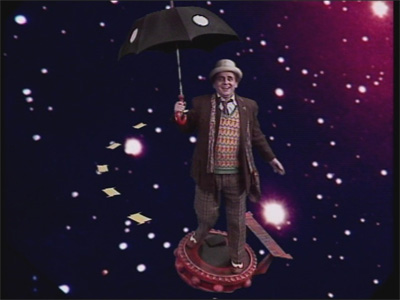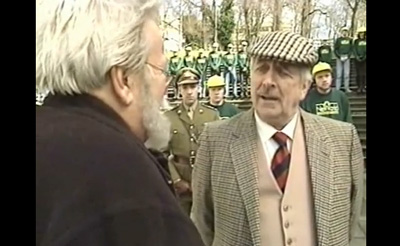Levine La Vida Loca
Friday, March 25th, 2011
Any fan who lived through Doctor Who‘s Wilderness years (that’s everyone who reads Zeus Blog for a start -Ed.) will recall a time when seeing the Doctor on screen was a desperate search and trawl through the mundane, the ridiculous, and the frankly bizarre. The series as we knew it was dead, and trawling out old (and even the current) Doctors to feature on other shows, advertise various everyday objects and foods on the strength of their nostalgia factor, became an exercise so obvious it began to look rather pitiful by the mid-Nineties.

We’d already come to a pretty pass when video fandom took on. Slow to start with the likes of Sgt Benton’s Wartime, the Stranger videos and 1993′s non-canon, out of character reunion The Airzone Solution, after another five years things got decidedly more earnest with some more daring spin-off media featuring Yetis, Sontarans, the Brgadier and Sarah Jane Smith – Shakedown, Downtime and the Mindgame and Auton trilogies became the new benchmarks for fan enterprise.


After another five years fans had a PC game, Destiny of the Doctors, to struggle through, with what became Anthony Ainley’s last ever recorded role as the Master. With the game play being at best sticky, most agreed that Ainley’s contributions were the highlight of a reliably duff product. And in any case there wasn’t much else to celebrate – the TV Movie had flopped where it mattered, and our next big hope was a Comic Relief skit featuring Rowan Atkinson.

You’d be forgiven for thinking that with the new series now firmly part of the TV establishment the rough likes of the Nineties could be quietly retired and filed alongside the New Adventures under ‘Worthy, but really – Watch This Space’. Only now they’re coming back, weirder than ever. This month on the eve of his trip down to Enzed for the biggest movie role of his career, Sylvester McCoy let slip news of some other old business he’d been sharing with superfan Ian Levine:
Ian Levine’s putting together a piece of work that didn’t get completed over the years, and I was there as The Doctor to kind of ‘Doctor Who’ them up. There are pieces that have been done too for The Brigadier and The Master that were never quite completed, so that work will make them a rounded whole. Also there’s the 30th anniversary show of Doctor Who that was never made, and we’re going to do a cartoon version of that. I was doing my role in that as well.
…there were a couple of projects that we were doing. One was actually filming to beef up a piece that’s already been done, and the other was recording voices with camera so they can do a lip-sync for the cartoon.
Later, pictures of McCoy in costume during the green screen filming surfaced on the same site. You can find them here. The resulting news, rumour and innuendo is a heady mix of money, opportunity and fanboy dreaming – a re-edited Downtime (to which Levine scored the DVD rights as part of his producer’s fee) featuring the Doctor. An animation of Adrian Rigelsfor’d notorious would-be anniversary story The Dark Dimension. A strange mash-up of bits of Destiny, McCoy’s parts in Search Out Space, possily also Mindgame and what looks to be new footage with a recast Celestial Toymaker, Padmasambhava (likely for Downtime 2.0) and (somehow) a Voc Robot. The mind boggles.
Levine’s past dream projects have been mixed in their success – a reconstruction of Power of the Daleks is yet to appear, his attempt to fund a recolourisation of Ambassadors of Death also disappeared, allegedly after the project became too taxing on resources. This scattergun apprach to the current projects – Levine has an animation of Shada on the boil as well – does little to waylay concerns one might have over their ever being fully realised. But it’s a hell of a dream to chase, and I can’t wait to see how it turns out, if it does.
In the mean-time though, questions. So many questions…

 The earliest association between the Doctor and acts of violence may well occur in An Unearthly Child where, notoriously, the first Doctor contemplates using a rock to euthanise a mortally-wounded caveman. Though he is ultimately interrupted, there is still something shocking to the scene; but not so much that the Doctor intends to kill a dying man, it’s that he sees it as an option. The Doctor Who universe has always been a dangerous place, and scarcely ten years after this scene the perils of his livelihood became a lot more visceral on-screen. ‘Body horror’ featured on a semi regular basis as a motif during the Philip Hinchcliffe-produced stories of the early Tom Baker years, as the tortuous effects of bodily transformation, mutation, and alien possession all formed part of the spectacle. Protests by Mary Whitehouse’s National Viewers’ and Listeners’ Association led much of the outright violence in Doctor Who to be curtailed, but it crept back – why? And why in the era of a Doctor whom many fans might consider the least aggressive of all, Peter Davison’s fifth Doctor?
The earliest association between the Doctor and acts of violence may well occur in An Unearthly Child where, notoriously, the first Doctor contemplates using a rock to euthanise a mortally-wounded caveman. Though he is ultimately interrupted, there is still something shocking to the scene; but not so much that the Doctor intends to kill a dying man, it’s that he sees it as an option. The Doctor Who universe has always been a dangerous place, and scarcely ten years after this scene the perils of his livelihood became a lot more visceral on-screen. ‘Body horror’ featured on a semi regular basis as a motif during the Philip Hinchcliffe-produced stories of the early Tom Baker years, as the tortuous effects of bodily transformation, mutation, and alien possession all formed part of the spectacle. Protests by Mary Whitehouse’s National Viewers’ and Listeners’ Association led much of the outright violence in Doctor Who to be curtailed, but it crept back – why? And why in the era of a Doctor whom many fans might consider the least aggressive of all, Peter Davison’s fifth Doctor?
 Less than a year ago the Eleventh Doctor made his debut, in a season-spanning arc that dealt with devouring fractures and spaces, a swallowing earth, memory, loss of life and time itself. Being the Doctor, our hero overcame all of these things, holding back fate and turning the Universe into his plaything, beating death. The events of last month remind us that, unlike our fictional idol, we can only achieve these sort of miracles (if at all) on small scale and under very special circumstances. Large catastrophic events are things we must instead live among, occasionally overshadowed by their awful immediacy. February was a hellish month for New Zealand, and even the world of Doctor Who fandom took blows as well – we lost friends and fellow fans in the Christchurch earthquake, and beyond these shores the series lost one of its most beloved actors.
Less than a year ago the Eleventh Doctor made his debut, in a season-spanning arc that dealt with devouring fractures and spaces, a swallowing earth, memory, loss of life and time itself. Being the Doctor, our hero overcame all of these things, holding back fate and turning the Universe into his plaything, beating death. The events of last month remind us that, unlike our fictional idol, we can only achieve these sort of miracles (if at all) on small scale and under very special circumstances. Large catastrophic events are things we must instead live among, occasionally overshadowed by their awful immediacy. February was a hellish month for New Zealand, and even the world of Doctor Who fandom took blows as well – we lost friends and fellow fans in the Christchurch earthquake, and beyond these shores the series lost one of its most beloved actors.